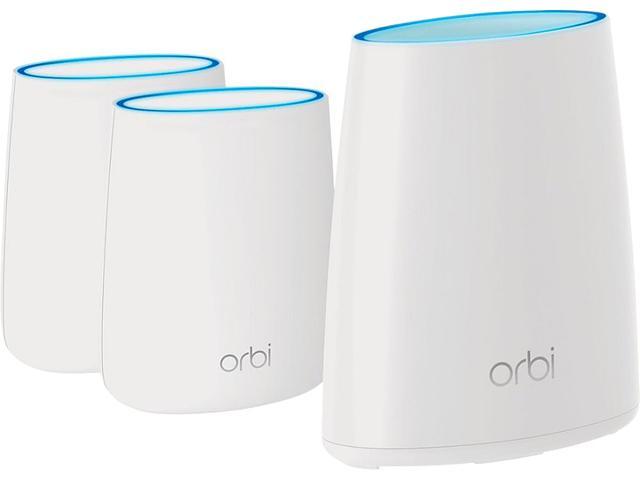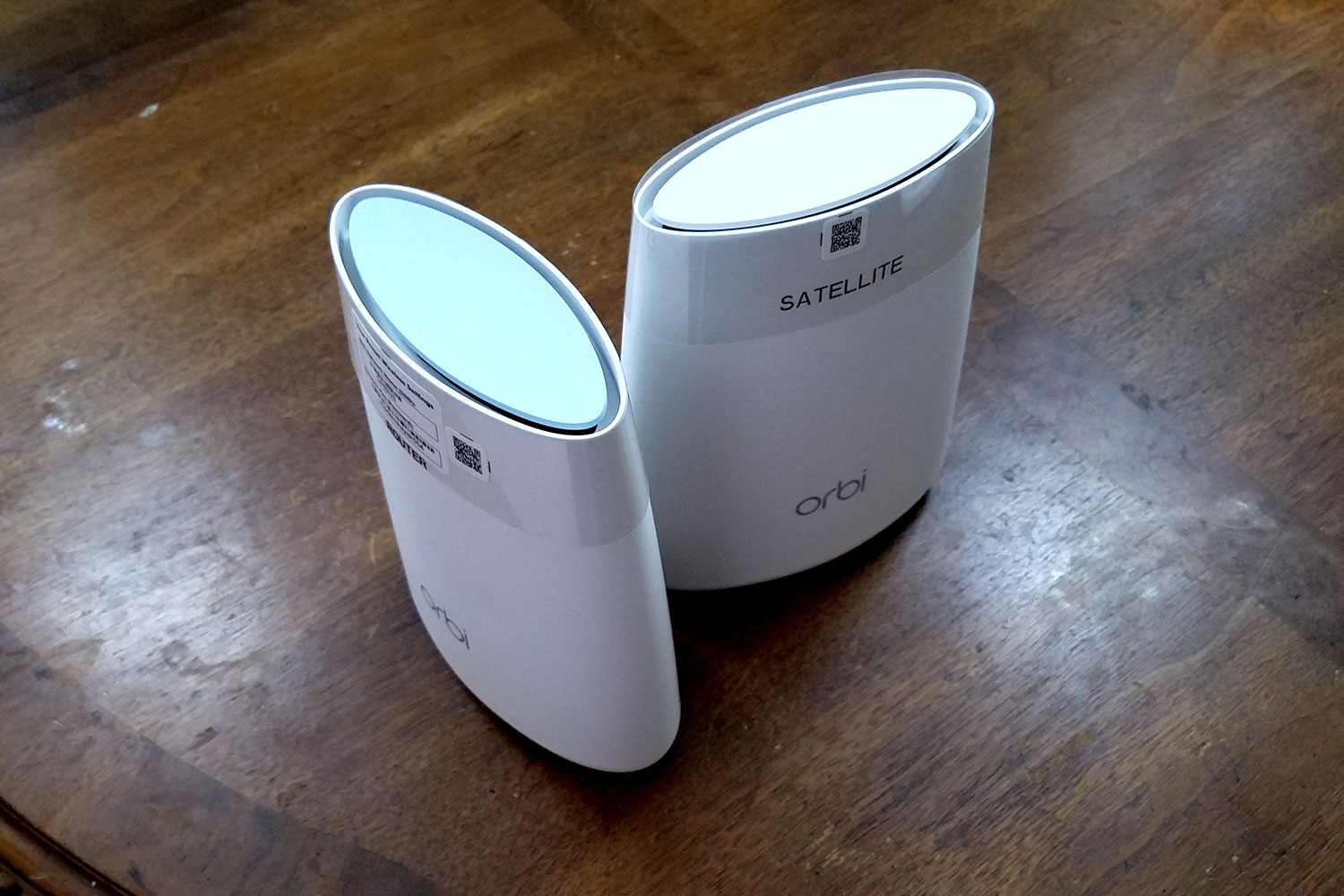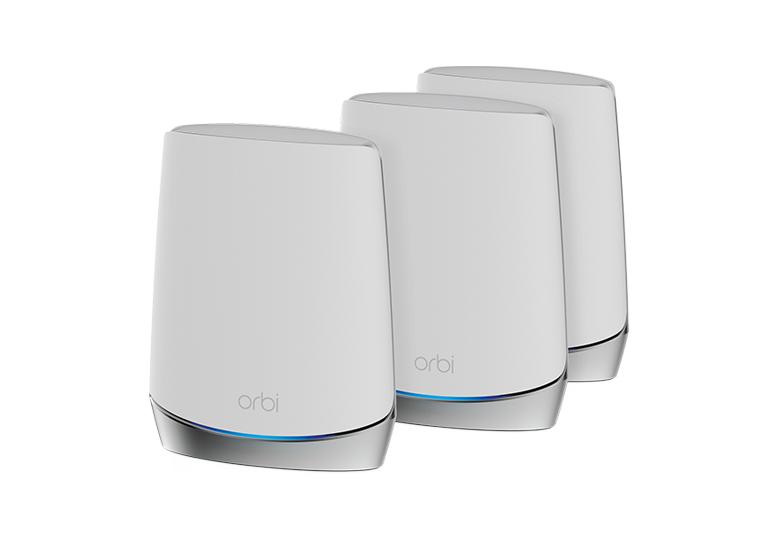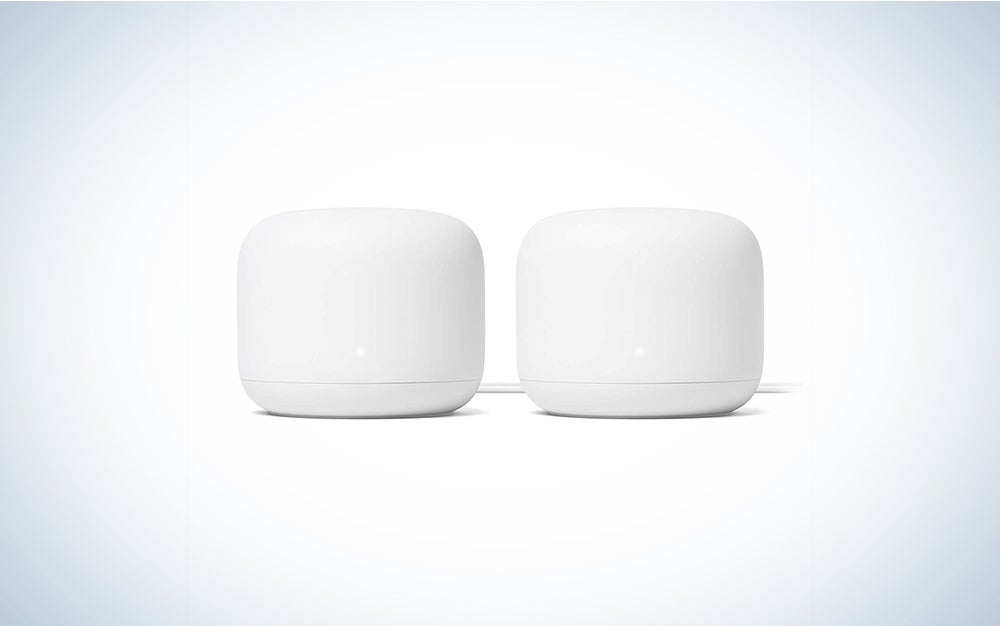Netgear Orbi Mini 2-Pack Ac2200 Review

Layout and Design
Anyone who is familiar with Netgear Orbi AC2200 RBK23’s design will instantly recognize it. The router and satellites look almost identical but have different dimensions.
The original Orbi router and satellites each measured 6.67 x 2.36 x 8.89 inches, while the Orbi RBK23 units measure 5.6 x 2.4 x 6.6 inches. This makes for a far less intrusive router and satellite system, and the design certainly looks nicer when shrunk down; the larger white units of the original Orbi were a bit too big to place around the home without them looking out of place, while these smaller units can be tucked away without calling too much attention to themselves.
As with the original, the three units look the same at first glance, but the top of the router unit has a faint blue finish. Each unit has two Ethernet ports for wired connections, although one of the router’s Ethernet ports is highlighted yellow and is labelled ‘Internet’. This port is where you will connect to your modem.
This means the router unit only has one spare Ethernet port for hooking up wired devices. The original Orbi system has four Ethernet ports for each satellite, and three Ethernet ports (and one reserved for connecting to the modem) on the router unit. This reduced connectivity might not be suitable for you if there are many devices that require internet connection. However, by cutting the amount of Ethernet ports, Netgear has been able to reduce the size and price of the Netgear Orbi AC2200 RBK23, and for households that use predominately wireless devices, this will be a welcome move.
The USB connection is another port that has been eliminated. The original Orbi, as well as many other routers, included a USB connection for sharing files and accessing a printer.
It’s a nice feature to have, and its absence in the Netgear Orbi AC2200 RBK23 will be disappointing to some, but for many people the port would have rarely been used, and if that’s the case then the lack of the port will be a price worth paying for the lower cost of the router.
The shrunk-down size – both physical and when it comes to price – has led to reductions elsewhere. While the Netgear Orbi AC2200 RBK23 offers simultaneous Tri-band Wi-Fi, as the original Orbi does, it has four internal antennas, compared to the original’s six. Although the internal antennas make the device look better, they can limit coverage. This is especially true for external antennas that are able to be placed to point at different devices.
The antennas are capable of beamforming, however, which is a feature that cleverly detects the location of devices connected to the Wi-Fi, and aims the wireless network towards that location for better coverage.
Overall, we think the design of the Orbi AC2200 RBK23 translates very well to the reduced size. In fact, we’d say it actually suits the smaller Orbi AC2200 RBK23 better than the original. The reduction in ports is understandable, in our view, as Netgear is aiming for a smaller, cheaper router that’s designed to appeal to more casual users who won’t use many wired devices, or want to share USB kit between PCs connected to its home network. If you do miss those features, then Netgear’s belief is that you’d be better off putting down money for the original Orbi.
You can use the same easy setup that you used to set up the Orbi AC2200 RBK23 system with the updated system. The instructions were followed and the router was connected to our modem. The app was clever enough to set the IP addresses the Orbi hands out to a number that won’t clash with the modem, which can often happen when you’re installing a new router and allowing it to act as a DHCP (Dynamic Host Configuration Protocol) server.
The router was set up in no time at all. Netgear is obviously confident that the setup procedure is straightforward, as the instructions it supplies, either in the form of the physical (and flimsy) manual that comes in the box, or through the app, are very basic. It can also be a problem if it leaves out important information or if something is wrong. This happened to us.
This is because after installing the router unit, the app asked us if we wanted to install the updated firmware for the unit. This was necessary to ensure that we could test the router using the latest software. However, this was to cause unforeseen problems, and nowhere in the documentation were we warned about these.
After the router unit was set up, it worked well. We then added a satellite unit to expand W-Fi coverage. You connect the satellite unit to your router by plugging it in, pressing the “Sync” button on the satellite and then the router button. The units will talk to one another. An LED light on each unit indicates when the units are connected. The process should be simple, but we hit a snag.
The router unit couldn’t find the satellite. The satellite unit was not in reach so we moved it closer. We were perplexed, and checked the documentation – and this is where the lack of in-depth documentation caused an issue, as while the manual explains what color the LED lights change to if there’s a problem, it does not say how to fix that problem.
We ended up searching the internet, and found a post on Netgear’s forums that provided the answer to our problems. The router firmware can only find satellites that have not been updated. You can also update satellite firmware by connecting to your router.
You need to connect the satellites, then update the satellite firmware first, before updating the router firmware, otherwise they won’t sync. We had to set the router back to factory settings, reconnect the satellites and then update firmware. While everything worked fine after that, it was time-consuming to fix the issue.
With that problem solved, however, the rest of the setup procedure went well, and the well-made app helped us finish setting up the system. If you don’t have a compatible phone, you can use your PC to connect to and set up the Orbi AC2200 RBK23 system.
This setup process is designed for casual users and is as easy as possible. But while this is great when things work as they should, if you’re after more control over your router setup, or need information when things don’t go as planned, then you may end up frustrated.
This is what the Netgear Orbi AC2200 RBK23 did in our short suite of tests, which were conducted on a 70Mbps connection.
If you liked this, you might also be interested in
Orbi Ax4200 Review
Ookla Speed Test 5GHz (Download | Upload):
17.9 Mbps
Within 13 feet/9.14 meters; three plaster walls: 68.7

Netgear Orbi Rbk20 Review: Connections And Features
Obviously, the Orbi is primarily a wireless system but at the rear of each unit you’ll find two Gigabit Ethernet ports. It’s not sufficient for home networks, as one port on each router is used by modem connections. However, it’s common in compact mesh systems. You can purchase a standalone Ethernet switch for a fraction of the cost, or you could use your existing router.
Other ports are not available. Power, Reset, and Sync buttons can be used to connect new clients through WPS or add satellites to your system. There’s no display as such but the rings around the top of the Orbi units glow in various colours to let you see at a glance that all is well or that something’s gone wrong.
It’s all so simple. If you can use your smartphone for Orbi management, there are very few more things to do. The app allows you to check the status of your network, see connected clients and adjust Wi-Fi settings. You can also test the connection speed. And. to be fair, that’s all that most users will need.
Those who want to get more hands-on, however, can turn to the Orbi’s comprehensive web-based administrative interface. From here you can set up a guest network, configure the DHCP range and enter VPN settings. You can also reserve IP addresses, allow port forwarding, and create a dynamic DNS server for external access.
A final strength of the Orbi is the inclusion of the “Circle with Disney” parental control system, which provides a flexible category-based web filtering service, plus per-device access scheduling. An optional $5-per-month subscription adds advanced features such as detailed usage monitoring, time limits and Alexa support, but even the free service is a step above what most routers offer.

Orbi
The Orbi router is a reliable device and has a lot of advantages too. The fastest internet speeds for devices. It is reliable and can allow multiple devices to connect simultaneously. If you like wired connection Orbi is a great recommendation for you due to its performance and stability even with wired connection. It has Ethernet Ports that allows up to four devices to be connected.
You can use it with any major internet provider, including Verizon, Fios and Comcast. It also works with Amazon Alexa, Verizon and Comcast so that you can control your network using your voice.
It also has additional controls such as parental control, which allows parents to control the time that children spend on the internet. It also controls what is watched and websites that are age inappropriate. This feature also allows parents to pause the internet from their devices. Orbi router also protects from online threats by providing your home from internet threats. This is done by providing an excellent anti-virus for all connected devices. Orbi also allows Guest Network which is used to secure homes Wi-Fi password by giving guests a separate and secure Wi-Fi network.
The Orbi router’s executive design is an additional key characteristic. It is a good fit in any room and serves a good aesthetic due to its white color.
Orbi router is just like any other product. It has some flaws, such as the high price. This one-time purchase might require some saving.
The pros
Cons
View price on Amazon

Installation
After I’d shut off my BT Smart Hub Access Point, I was able to set up Orbi. It was surprisingly easy, although I might have made some mistakes if it were over again.
Initially, the Orbi Router was set up in my office. It is the place where my master phone line enters, the main switch and my office. The Orbi Router was located in my office. I connected it to the power supply and noticed the lights. I then went to Google Play and downloaded the Orbi App. I then went to the other room in the house I knew I wanted an Orbi node, so I placed a Satellite there, plugged it in, saw the LEDs and went to the next Room and repeated. I made a mistake.
If you enjoyed this, you might like
Google Nest Wifi Review
I’d prefer to have set the satellites up in the same place as the Orbi router. This would ensure that my network settings are correct and allow me to connect. However, it was too late and I had to rush.
You should first set up your main Orbi Router. Then, plug in one Orbi Satellite into the room. Watch out for LEDs. There are four colours to them: Amber, Magenta and White.
Ideally, as they are in the same room, they should go blue to white, and then as everything is fine, the lights should turn off after a few minutes. If for some reason the light is magenta, press the sync button on the back of the router and the satellite for a few seconds, this puts them both into a pairing mode, they should find each other, go blue, then white. Once the first Orbi Satellite is connected, leave it plugged in, and do the same with the second satellite until it too is connected.
After all devices are connected, move the satellites into the appropriate rooms. Then wait for the lights to settle. Hopefully, it is close enough to the Router that the first satellite just connects no issue, and then when you install the second Satellite, it actually connects to the first satellite.
What I did is place each one in the room individually, then have to rush up and down 3 floors and each room to look at the LEDs and then decipher then from the quick start guide. Seriously, Don’t do it the way I did.
You can then never touch the settings ever again if you don’t want to, technically your network is now done, but if you get the Orbi app, then you can do some more cool stuff. You can perform a speed test from the app. This is provided easily by Ookla.net. You can check or change your WiFi settings, you can see what is connected and manually disconnect each device one by one if you feel like it. You can enable or disable the guest network and the respective settings and so much more.
My troubleshooting while I’m away from home has been made easier by the Orbi App. Because I had setup remote management I was able to log into the setup remotely from Berlin while I was there for IFA. I was able to check the settings and make any necessary adjustments. It was amazing.
Do you want something cooler? Or just nerdier perhaps? To Orbi can interface with Amazon’s Alexa and Google’s Assistant, meaning you can shout “Alexa, enable guest network” when your in-laws are over for the weekend, or “Alexa, what’s my WiFi status” if you’re just interested, Or you can simply just ask Alexa to reboot your router if something doesn’t seem right, something like this is a godsend for a lazy person like me who has Echos and home Minis all over the place.

Hardware
The Orbi Routers are built with a control chip known as a Qualcomm IPQ 4019 and radio of 710 MHz which has a storage space up to 4 GB and 512MB of RAM. It has an additional QCA9984 chip which minimizes backhaul data. It has six antennas and a tri-band main router.
Orbi can reach speeds of 3Gbps, while Orbi mini is able to achieve speeds of only 866 Mbps. With the Orbi router you are able to enjoy a high speed and hence making it suitable to be used in larger homes or a large group of people compared to Orbi mini which is suitable for smaller homes or a small group of people.
The app for your smartphone can allow you to install and configure both routers. Instructions on how to set up the connectivity are clear and easy to follow. You are then required to plug the satellite into a wall outlet a few feet from your router then using your phones Wi-Fi settings, connect your phone to the Orbi’s SSID, enter the keyword and within no time, the satellite is configured and then gives the system a name and password. The configuration process is quick and simple.
Orbi can handle up to two streams at once with its 2×2 configuration. The Orbi also features multi-user, multiple input and multiple output Wi-Fi technology that allows you to send focused data streams simultaneously to multiple devices.
If you appreciated this, you might also enjoy
Tp Link Deco Ac1200 Review
The Orbi mini router scored 411Mbps in multi-user, multiple input and multiple output performance tests. Orbi was able to connect with users from 150 feet away in a 3-story building. It is almost seven times faster than Google Wi-Fi. The Orbi mini router provided a speed of just 142Mbps from a distance of only 30 feet.

The Products
One day, I will be able to return and conduct individual reviews. However, due to the amount of backlog I have accumulated during the Wi-Fi System testing process, this may not be possible in the near future. Here’s an overview of the key features.
Their feature sets differ from traditional wireless routers so I created an entirely new product category for Wi-Fi Systems. They have their own Charts and Rankers, as well as their own Finder. The feature tables below are taken from the Finder, which has more information than I’ve chosen to highlight here. Although there are two main types of Wi-Fi system–mesh and extender–both are treated the same in the Charts and Ranker.
You may notice eero Beacon is not included in this test because eero sent only one Beacon along with the three-node Pro. I’d prefer to test a one-Pro, two Beacon configuration, so will arrange that for a future test.
Let’s first look at what is the same about all these products. All use multiple mini dual-band 802.11ac access points, that can themselves connect via Wi-Fi, to cover more area with higher bandwidth than a conventional single-point router, or at least that’s the plan. The mesh architecture is used by three of five. This allows APs, also known as mesh nodes (or mesh access points), to connect to one another to reach the root node that is connected to your modem. Orbis uses a simpler router/extension (aka “satellite”) method, in which satellites are limited to connecting to the router.
The advantage of mesh systems is that they can reach farther by having each node relay your data until it reaches the root. Each relay point, or “hop”, reduces bandwidth for devices that are connected to it.
These are 2×2 systems, even though marketing people have used class names. The two flavors of the Orbis mini, which NETGEAR prefers I refer to as the Orbi WiFi System AC2200 (with RBK40 being the version that has a desktop satellite and RBK30 the one with a wall-plugged satellite), still use 2×2 client-facing radios. But the Original Orbi’s dedicated 5 GHz backhaul radio has been downgraded from 4×4 to 2×2 to enable the mini’s lower cost.
The takeaway here is to not let the difference in numbers fool you, all the products in this group connect to your devices with maximum link rates of 867 Mbps in 5 GHz and either 300 Mbps for Google Wi-Fi or 400 Mbps for the others in 2.4 GHz.

